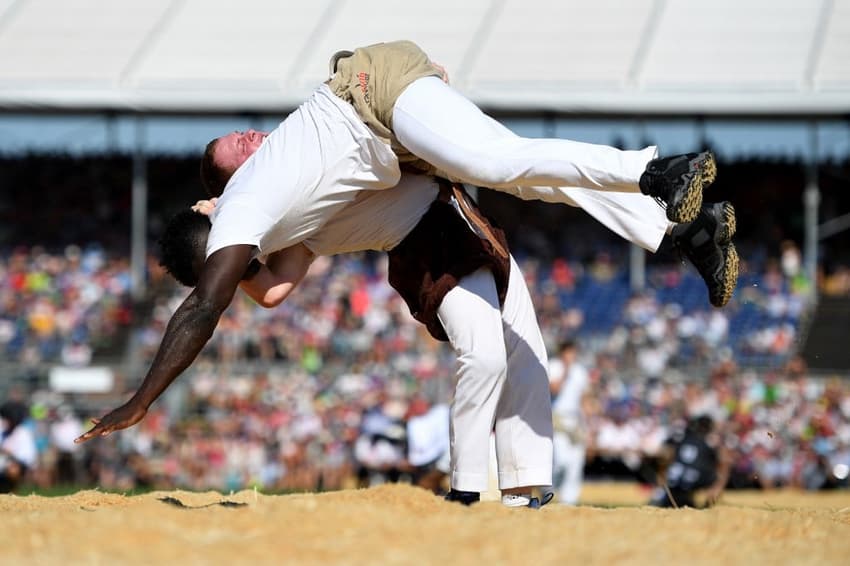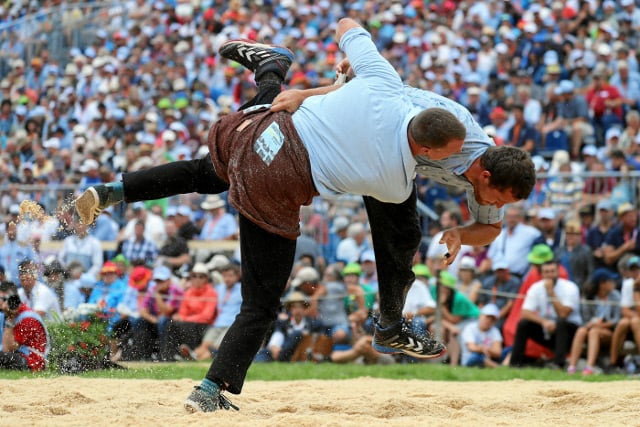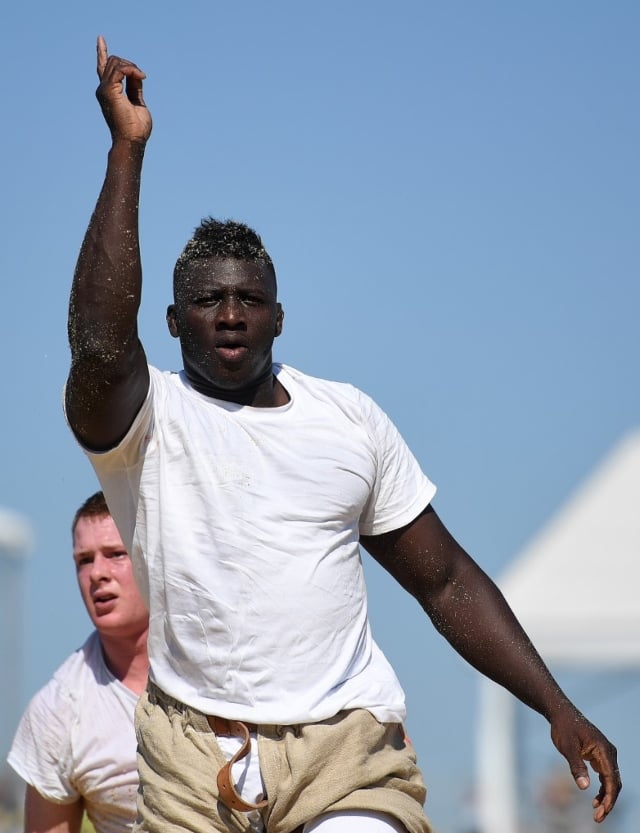Schwingen: Everything you need to know about Switzerland's 'national sport'

Schwingen, otherwise known in English as Swiss wrestling, is Switzerland's national sport. George Mills explains what you need to know.
There are not many amateur sports I know that can fill a 50,000 stadium with another 300,000 people viewing from outside the arena.
This is why ‘schwingen’ – as Switzerland’s traditional wrestling is known – holds a unique place in Swiss sport and culture.
In fact, the Federal Swiss Wrestling and Alpine Festival (ESAF) - which takes place every three years and is next scheduled for 2022 - is Switzerland’s largest sports event.
Zug-based sports writer Charlie Inglefield gives us the lowdown on a sport which is growing in popularity in modern Switzerland.
A sport on the up
The origins of schwingen (or ‘hosenlupf’ as its also called) date back to medieval times.
Today, schwingen’s popularity is on the rise thanks, in part, to the chiselled good looks of the 2010 winner, Kilian Wenger, as Brigitte Hefti explained to me. Hefti’s partner Rolf is a farmer and his family’s connection with schwingen goes back many generations.
“Since 2000, the popularity of the sport has soared. When Wenger won in 2010, schwingen became more saleable to the public and sponsors came on board,” Hefti said.
Not just about brute force
So what is schwingen? The easiest comparison to make is with wrestling. The rules are complex (you can read them here in German) but essentially the contest involves one round lasting between from 10–12 minutes.
The ‘schwinger’ who manages to throws his opponent onto his back (either fully, or as far as the middle of both shoulder blades) is the winner.
Wrestlers must always have at least one hand on the shorts of their opponent. For this reason, they wear special jute shorts over their trousers. These shorts have a slit at the back so that competitors can grab hold of each other.
Schwingen isn’t just about raw power, as Hefti explained: “You have to be in good condition and you need flexibility, power and technique.”
Farmers against city boys
There are two types of schwinger – the ‘sennenschwinger’ and the ‘turnerschwinger’.
The sennenschwinger traditionally come from alpine or rural areas and wear dark trousers and, generally speaking, a blue Edelweiss shirt. The turnerschwinger are traditionally affiliated with city sports clubs and wear white.
The King of Switzerland
The Federal Swiss Wrestling and Alpine Festival is hosted just every three years by one of the country’s five wrestling regions.
The competition lasts from Friday through to the Sunday and showcases traditional Swiss alpine culture and music alongside the main event, which consists of eight rounds of wrestling.

Matthias Sempach, winner of the Swiss national schwingen competition in 2013, overcomes an opponent in the ring. Photo: Andy Mettler/Swiss-image
Every participant goes through the same rounds and the winner is crowned the 'schwingerkönig', or the Wrestler King (the only king in republican Switzerland).
There are no cash prizes but the winner receives a bull, which is typically valued at 15,000 Swiss francs (around €13,800). Other prizes vary from a cowbell to an oven. These prizes come from the 'gabentempel' – or 'gift table', which contains prizes worth nearly a million francs in total. Everyone wins something.
An expat’s turn
Paul Timmins, who lives in Zug and has a rugby background, got a rude awakening to schwingen when he took on Hefti’s partner, Rolf, for the first time.
“I consider myself in relatively good nick for my age but I was taken to the cleaners and picked up like a rag doll,” he told me.
Timmins is one of very few non-Swiss to have given schwingen a go. This raises the question of whether schwingen should be more open participants from other countries such as USA.
But Joe Ming, former President of the West Coast Swiss Wrestling Association, told me it was it virtually impossible to challenge the Swiss when it came to schwingen.
“There will most likely never be a US champion. Because of our geography, there are not enough of the high-level wrestlers that live in one area where they can train all the time with the good guys,” he explained.
Ming is passionate about the sport – he made it to the magic round-eight mark in Bern in 1998 – and is quietly confident that the sport can grow in the USA.
“I can see schwingen growing on the West Coast, but it will take some time. There is a grass-roots effort that the clubs have adopted and it teaches the kids many of the cultural things that make Switzerland unique - food, music, beauty,” he said.
"If the kids start liking their culture, they are more inclined to want to participate in their culture’s sport,” he added.
The future of the sport
The ESAF organising committee has a budget of 32 million francs to make the event a success. With record numbers attending, and sponsors including John Deere and Zuger Kantonalbank, questions are now being posed about where the sport can go in future.
 Wrestler Diey Puye (R) celebrates after winning against Robin Straub during the first day of the 2016 Federal Alpine Wrestling Festival. Photo: AFP
Schwingen at the national festival is a very male-dominated sport, despite women taking up the sport in droves. There are now cardboard cutouts of the 2018 Champion, Sonia Kälin, alongside the men in Zug’s shop windows.
Wrestler Diey Puye (R) celebrates after winning against Robin Straub during the first day of the 2016 Federal Alpine Wrestling Festival. Photo: AFP
Schwingen at the national festival is a very male-dominated sport, despite women taking up the sport in droves. There are now cardboard cutouts of the 2018 Champion, Sonia Kälin, alongside the men in Zug’s shop windows.
Times are a changing within schwingen and just maybe in 2022 (Basel) there could be women taking part or we might see a foreign champion.
Comments
See Also
There are not many amateur sports I know that can fill a 50,000 stadium with another 300,000 people viewing from outside the arena.
This is why ‘schwingen’ – as Switzerland’s traditional wrestling is known – holds a unique place in Swiss sport and culture.
In fact, the Federal Swiss Wrestling and Alpine Festival (ESAF) - which takes place every three years and is next scheduled for 2022 - is Switzerland’s largest sports event.
Zug-based sports writer Charlie Inglefield gives us the lowdown on a sport which is growing in popularity in modern Switzerland.
A sport on the up
The origins of schwingen (or ‘hosenlupf’ as its also called) date back to medieval times.
Today, schwingen’s popularity is on the rise thanks, in part, to the chiselled good looks of the 2010 winner, Kilian Wenger, as Brigitte Hefti explained to me. Hefti’s partner Rolf is a farmer and his family’s connection with schwingen goes back many generations.
“Since 2000, the popularity of the sport has soared. When Wenger won in 2010, schwingen became more saleable to the public and sponsors came on board,” Hefti said.
Not just about brute force
So what is schwingen? The easiest comparison to make is with wrestling. The rules are complex (you can read them here in German) but essentially the contest involves one round lasting between from 10–12 minutes.
The ‘schwinger’ who manages to throws his opponent onto his back (either fully, or as far as the middle of both shoulder blades) is the winner.
Wrestlers must always have at least one hand on the shorts of their opponent. For this reason, they wear special jute shorts over their trousers. These shorts have a slit at the back so that competitors can grab hold of each other.
Schwingen isn’t just about raw power, as Hefti explained: “You have to be in good condition and you need flexibility, power and technique.”
Farmers against city boys
There are two types of schwinger – the ‘sennenschwinger’ and the ‘turnerschwinger’.
The sennenschwinger traditionally come from alpine or rural areas and wear dark trousers and, generally speaking, a blue Edelweiss shirt. The turnerschwinger are traditionally affiliated with city sports clubs and wear white.
The King of Switzerland
The Federal Swiss Wrestling and Alpine Festival is hosted just every three years by one of the country’s five wrestling regions.
The competition lasts from Friday through to the Sunday and showcases traditional Swiss alpine culture and music alongside the main event, which consists of eight rounds of wrestling.

Matthias Sempach, winner of the Swiss national schwingen competition in 2013, overcomes an opponent in the ring. Photo: Andy Mettler/Swiss-image
Every participant goes through the same rounds and the winner is crowned the 'schwingerkönig', or the Wrestler King (the only king in republican Switzerland).
There are no cash prizes but the winner receives a bull, which is typically valued at 15,000 Swiss francs (around €13,800). Other prizes vary from a cowbell to an oven. These prizes come from the 'gabentempel' – or 'gift table', which contains prizes worth nearly a million francs in total. Everyone wins something.
An expat’s turn
Paul Timmins, who lives in Zug and has a rugby background, got a rude awakening to schwingen when he took on Hefti’s partner, Rolf, for the first time.
“I consider myself in relatively good nick for my age but I was taken to the cleaners and picked up like a rag doll,” he told me.
Timmins is one of very few non-Swiss to have given schwingen a go. This raises the question of whether schwingen should be more open participants from other countries such as USA.
But Joe Ming, former President of the West Coast Swiss Wrestling Association, told me it was it virtually impossible to challenge the Swiss when it came to schwingen.
“There will most likely never be a US champion. Because of our geography, there are not enough of the high-level wrestlers that live in one area where they can train all the time with the good guys,” he explained.
Ming is passionate about the sport – he made it to the magic round-eight mark in Bern in 1998 – and is quietly confident that the sport can grow in the USA.
“I can see schwingen growing on the West Coast, but it will take some time. There is a grass-roots effort that the clubs have adopted and it teaches the kids many of the cultural things that make Switzerland unique - food, music, beauty,” he said.
"If the kids start liking their culture, they are more inclined to want to participate in their culture’s sport,” he added.
The future of the sport

Join the conversation in our comments section below. Share your own views and experience and if you have a question or suggestion for our journalists then email us at [email protected].
Please keep comments civil, constructive and on topic – and make sure to read our terms of use before getting involved.
Please log in here to leave a comment.